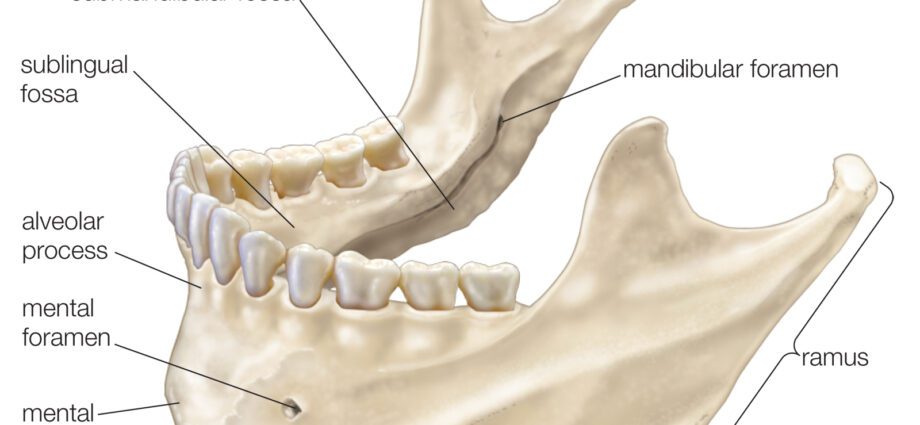Contents
Mandible
The mandible (from the Latin mandibula, jaw) is a part of the facial skeleton and constitutes the bone of the lower jaw.
Anatomy of the mandible
Structure. The mandible is an odd bone that articulates with the skull to form the lower jaw. The largest and most robust bone in the face, the mandible is made up of two parts (1) (2):
- The body. Horizontal part in the shape of a horseshoe, the body forms the chin. On the upper edge of the body, the mandible is hollowed out with cavities where the lower teeth are inserted.
- The mandibular rami. The mandible has two branches on either side of the body. These mandibular rami articulate with the lateral surfaces of the skull. The angle between each ramus and the body of the mandible forms the mandibular angle. The tops of the mandibular ramus are made up of the mandibular notch bordered:
– the coronoid process of the mandible, located towards the front of the face, and serving as an attachment to the temporal muscle, the latter having the role of lifting the mandible during chewing.
– the mandibular condyle, located towards the back of the face, and articulating with the temporal bone to form the temporomandibular joint, involved in the movements of the mandible.
Innervation and vascularization. The mandible has different foramina which are orifices allowing the passage of nerves or vessels. At the level of the rami, the mandibular foramina allow the passage of the nerves while at the level of the body, the mental foramina allow the passage of the nerves and blood vessels towards the chin and the lower lip.
Physiology of the mandible
Through the temporomandibular joint, the mandible performs different movements.
- Lowering / raising. It constitutes the opening and closing movement of the mouth.
- Propulsion / reverse propulsion. The propulsion corresponds to a downward and forward sliding of the mandible. The retropulsion corresponds to the reverse movement.
- Diduction. It corresponds to the lateral movements of the mandible.
Role in food. The mandible plays an essential role in chewing food.
Role in speech. The mandible has a major role in speech since it allows the mouth to open.
Mandible pathologies
Mandible fracture. In the event of a direct impact, the mandible may fracture. The most frequent fractures are those of the mandibular condyle. Symptoms include sharp pain and abnormal mobility of the mandible (3).
Temporomandibular joint dysfunction syndrome. These symptoms include pain when opening the mouth, joint noises such as clicking, abnormal mobility of the jaw or even tinnitus (4).
Mandible treatment
Medical treatment. Depending on the pathology, different treatments are prescribed such as painkillers, anti-inflammatories or antibiotics.
Surgical treatment. In the event of a fracture, surgical intervention may be performed such as, for example, the installation of screws and plates.
Orthopedic treatment. Depending on the pathology, the fitting of an orthopedic device may be carried out.
Mandible examinations
Physical examination. First, a clinical examination is performed in order to observe and assess the symptoms perceived by the patient.
Medical imaging examination. CT scan, MRI, or orthopantomogram can be used to confirm a diagnosis in the mandible.
History and symbolism of the mandible
In 2013, a fragment of a mandible was discovered in the Afar region of Ethiopia. Dating back 2,8 billion years, it is believed to be the oldest fragment of its kind Homo discovered so far (5).










